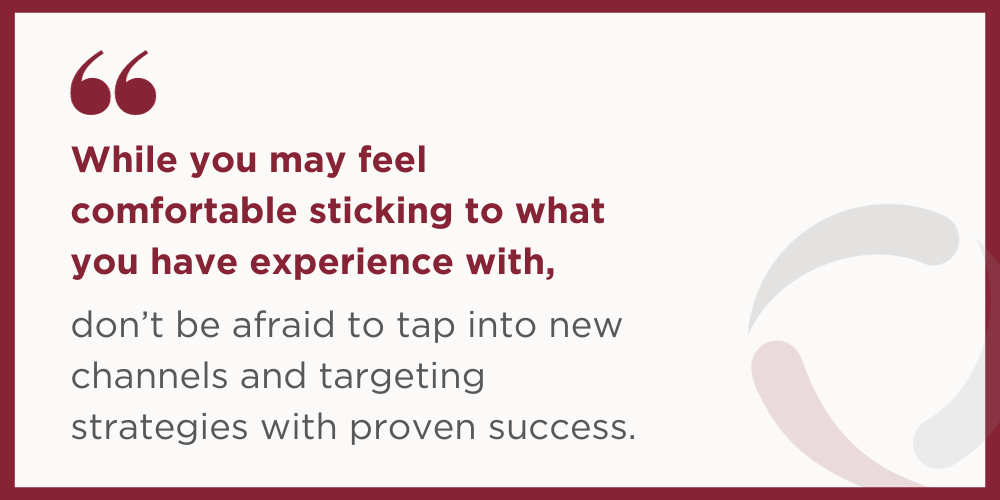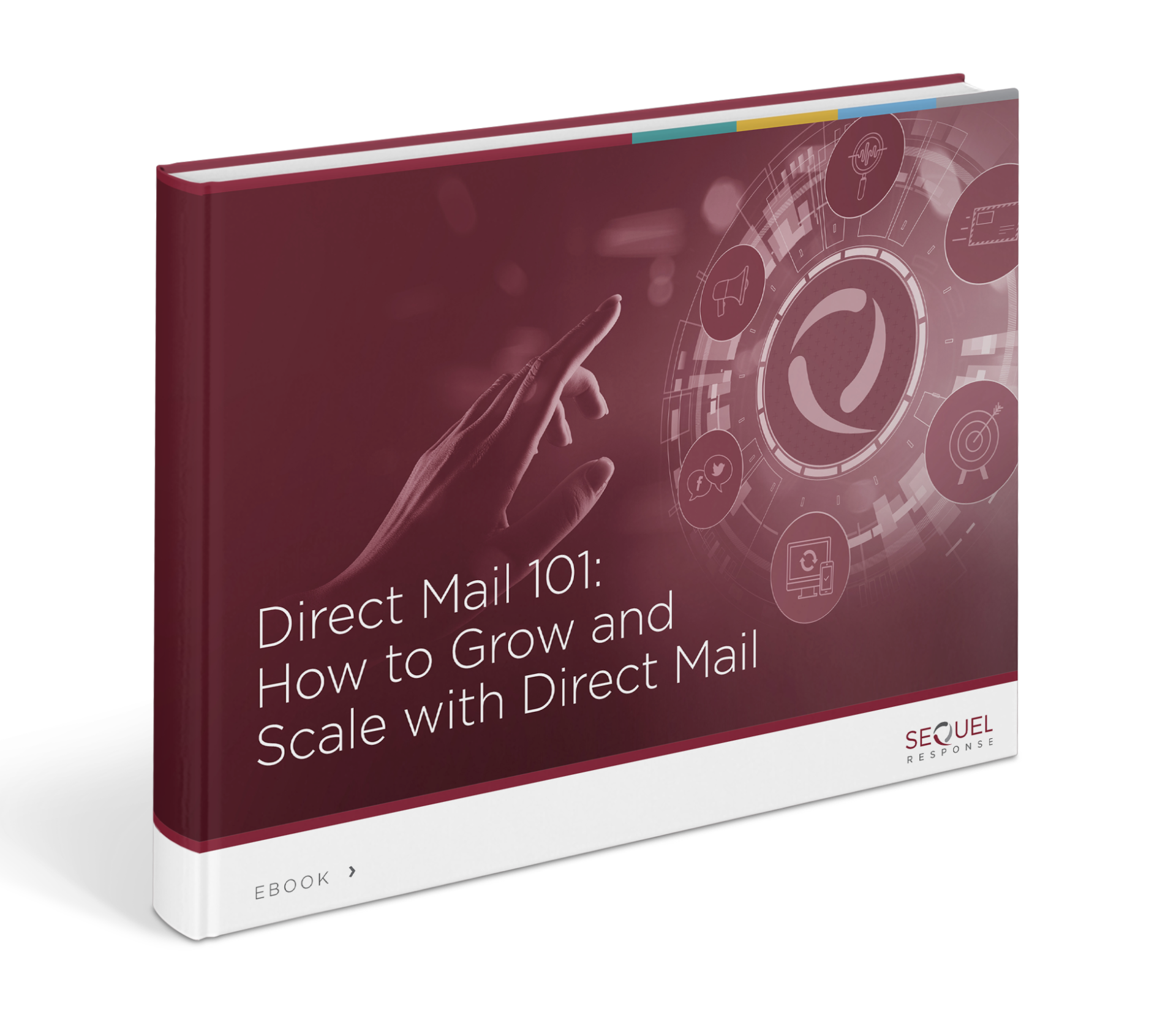The Fork in the Road: What’s Next for My Direct Marketing Strategy

Brand recall, trust, and retention is higher when your message is visible and cohesive across multiple channels. So naturally, when you find your digital channels approaching their customer acquisition ceiling, you know it is time to diversify your direct marketing strategy with a new media. Linear TV, Connected TV (CTV|OTT), influencer marketing, direct mail digital audio, and SMS marketing are all viable options, but where should you turn first? We call this the fork in the road.
When budgets are tight and expectations are high, investing in an unfamiliar channel can be intimidating. But identifying the next best pivot for your brand doesn’t have to be. If the direct mail channel is new to your brand, download the free e-book, Direct Mail 101: How to Grow and Scale with Direct Mail. Inside you’ll find 7 short how-to guides to help you build a targeted and valuable direct mail program.
Keep reading for an overview of today’s emerging channels to help you determine which direct marketing strategy is best for your brand’s growth goals.
Linear TV: Brand Awareness with a Twist
Linear TV (LTV) has experienced staggering ad spend in recent years, with slight fluctuations and increases showing no clear pattern. Marketing Charts reported an anticipated 8% decline in linear TV ad spend this year, dropping from $66.64 billion in 2022 to $61.31 billion in 2023. This could be due to an unstable economy, shifts in TV to CTV viewership, and/or downward pricing pressures.
Despite being recognized for its ability to reach large audiences and boost brand awareness, LTV’s attribution is far from the sharpened measurements available to digital media users. You may see an increase in website traffic or obtain minimal data from purchasers who indicated they saw your ad on TV during checkout — but some marketers question if these metrics are truly measurable and actionable.
While quantifying its exact impact can be tricky, the overall reach and exposure can contribute to your brand’s success. Embracing the potential of LTV alongside other direct marketing channels creates a well-rounded strategy that maximizes your brand’s visibility.
CTV|OTT: A Stream of Opportunities
For more than a decade, viewing trends have been shifting toward streaming and over-the-top (OTT) services. COVID-19 pushed this even farther, significantly impacting the emergence of CTV. Post-pandemic, CTV viewing is higher than ever. CTV|OTT advertising is sold on a cost per thousand (CPM) basis, starting at CPMs of $15 – $50, but quickly increasing based on inventory quality.
If you have yet to pull the trigger on this channel, be aware that increased competition has left limited inventory for novice advertisers and programmatic-only traders. In today’s market, securing premium slots requires early commitment since many seasoned purchasers have already negotiated and reserved their preferred positions.
Although digital natives appreciate the granular targeting and retargeting capabilities offered by CTV and OTT, the inconsistencies among platforms, devices, and providers make efficient targeting, frequency management, attribution, and measurement incredibly complex. As with linear TV, producing professional, quality advertising content can cost upwards of hundreds of thousands of dollars based on your creative vision.
Being aware of the complexities and potential costs of these platforms will help you set realistic expectations and create meaningful strategies that feature the unique strengths of CTV and OTT advertising. Both can become valuable components of your marketing mix with careful audience planning and the right approach.
Influencer Marketing: Authenticity and a Social Spark
In response to rising consumer distrust in brand marketing, marketers have expanded their social media strategy to include influencers. The State of Influencer Marketing 2023: Benchmark Report found that 83% of marketers believe influencer marketing is effective, and 82% are budgeting for influencer marketing in 2023. Yet in that same report, more than half of respondents indicated they have experienced influencer fraud, and that’s not the only concern.
This form of marketing can be a great enhancement to your social strategy and help expand your audience reach, but it will not provide the clear actionable analytics or attributable ROI of traditional channels. If you have a niche product or service, it can also be a challenge to find an influencer whose persona and audience aligns with your brand and marketing plan. Influencer costs are based on audience reach, type of partnership (i.e., exclusivity, shout outs, or giveaways), their average engagement rates, and the type of post (image, video, audio) you are requesting. Sponsored posts can be as cheap as $1,000 each or up to $500,000 for top celebrity endorsements.
Despite these considerations, influencer marketing is a powerful way to connect with your target audience and gain their trust in real-time. By meticulously choosing influencers who align with your brand values, and by negotiating fair partnerships, their influence can significantly benefit the promotion of your new products or services.
Digital Audio: Making a Boom
Digital audio has provided advertisers with new avenues for growth that conventional radio has never been able to match. By 2027, it’s projected there will be 174.20 million listeners. Digital audio is everywhere, whether it’s the podcast you enjoy during your daily commute, the songs you play on your smart speakers, or the live sports broadcast you stream on your tablet.
As demand for digital audio skyrockets, so does the competition among advertisers. The time of year can significantly influence this dynamic. Holidays and major events like The Super Bowl can increase demand, therefore driving up costs and diminishing availability.
Nonetheless, this channel provides an opportunity to communicate with consumers while utilizing some of the most powerful ad tech solutions. A direct marketing campaign using digital audio makes sense for anyone trying to connect with consumers when and where they’re spending time with media — in a personalized and highly measurable way.
SMS/MMS (Text): Don’t Leave this Channel Unread
With more mobile subscribers than ever before, the U.S. is anticipated to become a key revenue market for SMS (short message service) and MMS (multimedia message service). As two well-established types of direct marketing, companies love their ability to reach their audience, boost sales, foster brand loyalty, and achieve other benefits that email marketing cannot.
It is important to note that there is a learning curve involved. Businesses that use text messaging as part of their marketing efforts must abide by strict privacy rules due to heavy regulation of SMS/MMS. Additionally, text advertising lags significantly behind in terms of user experience (UX). Messages must remain text-based, making it difficult to emphasize important content, incorporate anchor text links, or optimize visual clarity. You must also consider that some consumers may find this type of messaging too intrusive and may respond negatively to unwanted or recurring texts.
Yet when integrated into a broader marketing strategy, you can expect high open rates, conversion rates, and limited competition. SMS/MMS holds great potential and can deliver a promising return on investment (ROI) — it all depends on how you apply it.
Direct Mail: Yes, You Can Have It All
As one of the most effective channels for customer conversions, direct mail marketing has sustainably supported the growth of countless DTC and e-commerce brands. Mail has all the targeting and attributable elements you love about digital marketing, with the added benefit of being a tangible media. Its versatility lends to success in prospecting, re-targeting, and CRM-based mail campaigns, while strategic testing capabilities enable you to quickly optimize your program for continued conversions and scale. These positive attributes could be why ANA research found direct mail response rates are higher than the most popular digital channels.
While direct mail can be a highly effective strategy for engaging your best customers, it has a longer project timeline than digital channels. Planning, designing, and executing a direct mail campaign can take an average of 4-8 weeks. It requires coordination with mailing and printing services, as well as managing the logistics of mailing lists and delivery. Most DTC marketers report the average campaign CPA is less than $150.
The time and budget you invest in mail is worth it for all the benefits, including how well it fits into a multichannel strategy. Direct mail can integrate well with digital channels (such as email marketing, social media, and CTV) to boost customer acquisition, consumer spending, and brand recognition. Onboarding your direct mail audiences into an online environment allows you to reach your best prospects on the platforms they interact with each day, naturally guiding them to the next step in their buyer journey. However, running a seamlessly coordinated campaign can be difficult to implement and manage at scale. Partnering with a direct marketing agency ensures your strategy, audience, creative, and mail package not only achieves your campaign goals, but also maximizes performance.
Right Channel, or Right Audience?

One thing’s for certain: each of these direct response channels has unique costs and benefits. There really is no “right answer” to which direct marketing strategy is best for your brand’s growth goals. Instead, we recommend you shift your focus towards understanding and targeting your best audience. Offline data, for instance, provides a more comprehensive view of the customer journey, capturing touchpoints that may not be fully obtained through digital channels alone. Using this data can help you identify potential customers, tailor marketing messages to specific segments, and optimize the overall customer experience.
This is where testing becomes your best friend. You will increase your odds of securing higher sales rates, lower CPAs, increased lifetime value, and more if you conduct frequent and extensive testing. Whether you decide to test channels, lifts, or other factors, the end goal is knowledge. By understanding what does work, and what doesn’t, you can protect your budget from wasted spend.
Your customers should be the root of every decision you make. While you may feel comfortable sticking to what you have experience with, don’t be afraid to tap into new direct marketing channels and targeting strategies with proven success. If the COVID-19 pandemic taught us anything, it’s that we should all stay flexible and respond to market trends and fluctuations. If marketers are experiencing success in reaching audiences through new and innovative methods, it might be worth considering.
When you come to the fork in the road, consider anchoring your marketing program in versatile and scalable channels that can support your current and future growth goals with measurable results, as well as high-quality data. Most importantly, invest in channels that can be integrated into your overall direct marketing strategy for a holistic approach to customer reach and connection.
Give us a call to learn how to responsibly test the direct mail channel and incorporate your digital channels to reach your best audience and optimize program performance.


